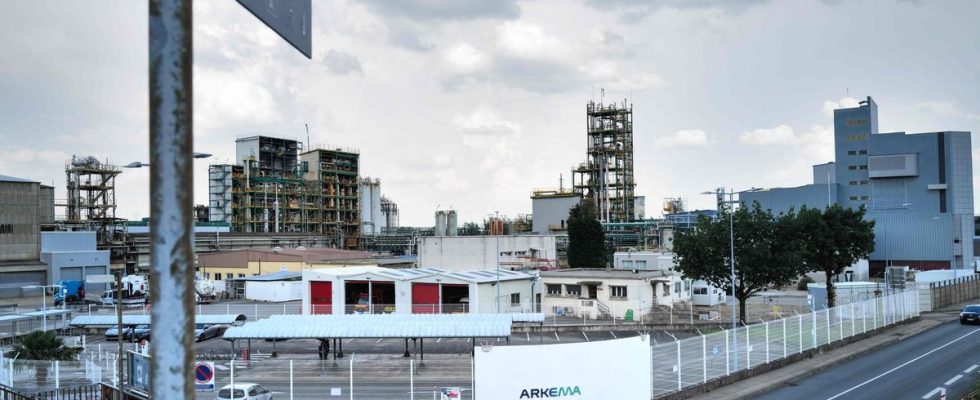“When you live in an area with a high concentration of industries, you live with sirens in your head, prepared for accidents, exclaims Claudie Grizard, 64. But we do not expect this kind of danger to our health. ” The danger ? These are the per- and polyfluoroalkyls (Pfas), in other words the “eternal pollutants”. Chemical components, used by manufacturers, then released into the water or the air. Very resistant to degradation in the environment and very mobile, they often nest in the food consumed.
In the Lyon region, it is now not recommended to eat fish caught in the Rhône and the Garon, eggs from several municipalities, as well as certain vegetables. “Only the air we breathe remains? asks Claudie, who has lived in the Chemistry Valley for forty years, one of the areas most contaminated by Pfas in France. She is one of thirty-seven residents, including sixteen children, who decided to take legal action on May 25 through a ” environmental criminal summary so that “the polluters finally take their responsibilities”.
Measure “the extent of contamination”
The first target is the Arkema site in Pierre-Bénite. The applicants demand a study on the health risks associated with these “eternal pollutants” to measure “the extent of the contaminations”. But also sanctions against the industrialist so that he stops dumping his pollutants in the water.
Since May 2022 and the revelations of the France Télévisions documentary, analyzes and investigations have multiplied around Pfas, suspected of being the cause of numerous diseases.
If Claudie is involved in the procedure against Arkema, it is above all because she is “worried about [ses] girls and [ses] grandchildren”. According to the last report of the General Inspectorate for the Environment and Sustainable Development (Igedd), several “eternal pollutants” act as endocrine disruptors and also promote the appearance of serious pathologies in the liver, pancreas or even the spleen.
“We know that these pollutants can cause cancer of the thyroid and testicles, develops Camille Panisset, general secretary of the Lyon branch Our business to all – who initiated this legal action. Among the residents, a child under the age of two suffered from testicular cancer. »
The association wishes to obtain “blood samples and analyzes paid for by Arkema” on breast milk or foodstuffs from organic and non-organic producers in order to “evaluate contamination that could have been avoided”. “The people affected would like to know the impregnation of these components in their body to find out if a link has been established with these diseases”, insists Camille Panisset. A survey of France 3 Auvergne-Rhône-Alpes rightly revealed a very strong presence of Pfas in the blood of residents living near the Arkema site. But the group affirms in a press release that “the Pierre-Bénite site complies with all the regulations regarding its industrial discharges and is regularly checked by the authorities”, adding that it “is not the subject of any remains to this day”.
350,000 people affected by this pollution
“The objective of the summary procedure is to obtain answers”, rebounds lawyer Louise Tschanz, denouncing “serious laxity on the part of the State and a kind of health and environmental banditry by Arkema”, which knew the situation. since 2011, she said. This action is “only the beginning of a scandal of immense proportions”, she predicts, estimating at 350,000, the number of “people potentially concerned”.
Indeed, it is not only in the Lyon region that Pfas pollution is the subject of legal proceedings. This Monday, the NGO Future generations announced that it had filed several complaints against X for water pollution, damage to the environment and to fish in three French regions: Hauts-de-France, Bourgogne-Franche-Comté and Pays de la Loire.
For the first complaint, the association relies on measurements it had carried out in the waters of the Oise, along the chemical platform of Villers-Saint-Paul, near Creil. Several manufacturers are located there, including Arkema, which has already pointed the finger at Pierre-Bénite. “This platform was part of the Pfas pollution “hotspots” on the map revealed by The worldlast February,” says François Veillerette, spokesperson for Générations Futures.
“No improvement in a decade”
The analyzes confirm this. “While upstream, there are very few PFAS, of the order of 7.5 nanograms per liter (ng/l), this concentration climbs to 4,100 ng/l where industrial discharges mainly take place, explains François Vigilance. It’s colossal. Fifty meters downstream from the site, the concentration was still 1,100 ng/l. “Which is still very important.”
Générations Futures then recalls that ten years ago, ANSES had already taken samples in the same area. She had then noted levels of Pfas pollution comparable to those found today. “We can be surprised that the situation has not improved over the decade”, points out François Veillerette, according to whom these results illustrate the inaction of the State in this file.
The second complaint from Générations Futures targets the Tavaux area in the Jura, which hosts a Solvay plant, one of the five French producers of Pfas. The third targets the Paimboeuf area in Loire-Atlantique for which data from the Igedd report showed significant releases of PFOS.
“There is a big lack of data on these pollutions of Pfas and by filing a complaint against X, the hope is also that the criminal investigation which will be launched will make it possible to highlight the extent of these pollutions as well as the extent violations of the various actors involved”, justifies Maître Hermine Baron, the lawyer for Générations Futures in this case. The NGO suggests that other similar complaints could still follow concerning other sites.

